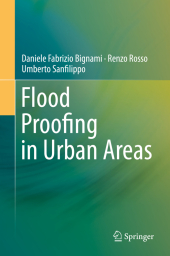 Neuerscheinungen 2019Stand: 2020-02-01 |
Schnellsuche
ISBN/Stichwort/Autor
|
Herderstraße 10
10625 Berlin
Tel.: 030 315 714 16
Fax 030 315 714 14
info@buchspektrum.de |

Daniele Fabrizio Bignami, Renzo Rosso, Umberto Sanfilippo
(Beteiligte)
Flood Proofing in Urban Areas
1st ed. 2019. 2019. xiv, 268 S. 30 SW-Abb., 149 Farbabb., 100 Farbtabellen. 235 mm
Verlag/Jahr: SPRINGER, BERLIN; SPRINGER INTERNATIONAL PUBLISHING 2019
ISBN: 3-03-005933-2 (3030059332)
Neue ISBN: 978-3-03-005933-0 (9783030059330)
Preis und Lieferzeit: Bitte klicken
Flood control in urban areas can be feasibly and cost-effectively enhanced by implementing flood proofing approaches to risk reduction in the context of environmental and land-use planning and management. Indeed, flood proofing makes it possible to improve, integrate and in some cases even replace traditional measures for flood control, reducing the vulnerability and increasing the resilience of buildings and infrastructures.
This book begins by reviewing the physics of stability and instability of both human beings and buildings under flood conditions, together with criteria and models (both conventional and innovative) for assessing flood strains. In turn, it presents a range of flood proofing concepts and techniques, together with a complete and updated classification of related methods and devices. This provides a user-friendly tool to help identify appropriate solutions to real-world problems for each specific risk scenario.
In particular, the book focuses on temporary flood proofing techniques, given their ability to deliver effective performance at low costs. Lastly, it features an overview of norms, guidelines and laboratory recommendations that are currently being adopted in various countries with regard to flood proofing devices and testing procedures.
The purpose of this book is essentially to encourage authorities, stakeholders, technicians and end users to successfully develop flood proofing solutions that can reduce flood risk in a pragmatic manner. In addition, the authors hope to inspire researchers, manufacturers and designers (engineers, architects, urban planners and urban managers) to pursue further advances in this key sector of public and private safety in urban areas.
Contents Foreword 1. Introduction 2. Flood Impact on Buildings 2.1. Introduction 2.2. Evaluation Criteria 2.3. Comparison between Different Criteria 3. Flood Impact on Human Beings Stability 3.1. Introduction 3.2. Models of Human Beings Stability 4. Flood Impact on Mobilizable Objects 5. Global Criteria for Impact Estimation 5.1. Introduction 5.2. New South Wales (Australia) Criteria 5.3. ESCAP Criteria 5.4. CEDEX (Spain) Criteria 5.5. Indications of Po River Catchment Authorithy (Italy) 5.6. FEMA (USA) Criteria 5.7. Comparison of Different Approaches 6. Hydrodynamic Criteria for Impact Evaluation 6.1. Introduction 6.2. Hydrodynamic Thresholds 6.3. Implementation of Hydrodynamic Thresholds 7. Flood Proofing Methods 7.1. Overview 7.2. First Level Classification (Strategic Planning) 7.3. Design and Assessment Principles - Introduction 7.4. Temporary flood proofing as an emerging strategy for adaptation and regional resilience 7.5. Insurance discount, premium reduction and tax handle 7.6. References 8. Temporary flood proofing techniques planning 8.1. Approach to arrangement and activation 8.2. Decision factors - The SENSO Model 8.3. Temporary flood proofing response planning 8.4. Defence lines 3 8.5. A notable requirement case: Pisa (Italy) - or where, probably, the modern temporary flood proofing was started 8.6. Effectiveness analysis: a path towards better design procedures 8.7. References 9. Temporary flood proofing devices analysis 9.1. Recapitulating 9.2. Description of temporary flood proofing proposed classes 9.3. Emergency flood proofing techniques as ´transitional solutions´ to support adaptation policies towards urban redevelopment and building restoration 9.4. References 10. Tests, Guidelines and Norms 10.1.Overview 10.2. Single Building Defence (Inner Line of Defence) 10.3.Australian Guidelines 10.4. European Guidelines 10.5. FM Approval Standard 10.6. SMARTeST project, Flood Resilience Technologies 10.7. Performance Evaluation about Protection Devices according to CSTB 10.8.DEFRA / Environment Agency 10.9. Temporary Defences according to VKF 10.10. Other Documents


